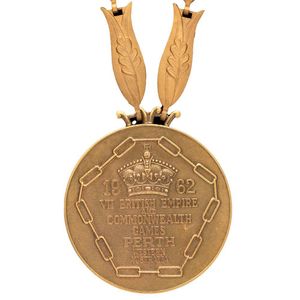Gold Medal for 1650 Yd Men's Freestyle Swimming, Perth 1962
The British Empire and Commonwealth Games Gold Medal Perth 1962 awarded for the 1650 yard men's freestyle swimming final race held on 30 November 1962. The obverse embossed '19 [imperial crown] 62 VII British Empire and Commonwealth Games Perth Western Australia' surrounded by a pentagonal chain of rectangular links. The reverse embossed with a wreath of kangaroo paw flowers and leaves surmounted by the coat of arms of the city of Perth and engraved to the centre 'Swimming 1650 Yds Freestyle (men) M. Rose Australia. Embossed to the bottom edge 'K. G. Luke. Melb.' and completed by a chain comprising 22 fish-shaped links embossed with oak leaves and a small ovoid link engraved to the back 'K.G. Luke Melbourne Australia'. Gilt silver 156 grams; medal diameter 57 mm; chain length 415 mm. Provenance: Murray rose Am, Sydney. The Estate of the late Murray rose Am, Sydney
You must be a subscriber, and be logged in to view price and dealer details.
Subscribe Now to view actual auction price for this item
When you subscribe, you have the option of setting the currency in which to display prices to $Au, $US, $NZ or Stg.
This item has been sold, and the description, image and price are for reference purposes only.
- Oviform /ovoid - The outline loosely resembling the shape of an egg.
- Obverse - Obverse means the front face of a coin or medal, and the reverse means the back face. The obverse of a coin is commonly called heads, because it often depicts the head of a monarch or famous person.
- Embossed / Repousse - Embossing, also known as repousse, is the technique of decorating metal with raised designs, by pressing or beating out the design from the reverse side of the object.It is the opposite of chasing, where the decoration is applied from the front. An embossed or repoussed object may have chasing applied to finish off the design.
- Oak - Native to Europe and England, oak has been used for joinery, furniture and building since the beginning of the medieval civilisation. It is a pale yellow in colour when freshly cut and darkens with age to a mid brown colour.
Oak as a furniture timber was superceded by walnut in the 17th century, and in the 18th century by mahogany,
Semi-fossilised bog oak is black in colour, and is found in peat bogs where the trees have fallen and been preserved from decay by the bog. It is used for jewellery and small carved trinkets.
Pollard oak is taken from an oak that has been regularly pollarded, that is the upper branches have been removed at the top of the trunk, result that new branches would appear, and over time the top would become ball-like. . When harvested and sawn, the timber displays a continuous surface of knotty circles. The timber was scarce and expensive and was used in more expensive pieces of furniture in the Regency and Victorian periods.
This item has been included into following indexes:
- British Empire Games - memorabilia 62
- Commonwealth Games - memorabilia 94
- Olympic Games memorabilia - medals and badges 201
-
Olympic Games memorabilia, by city
- Melbourne, 1956 306
- Sydney, 2000 191
